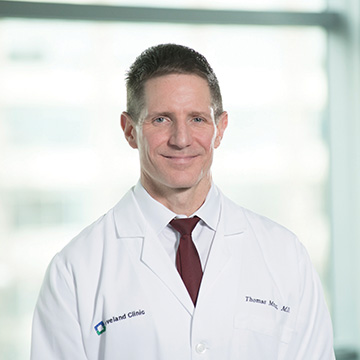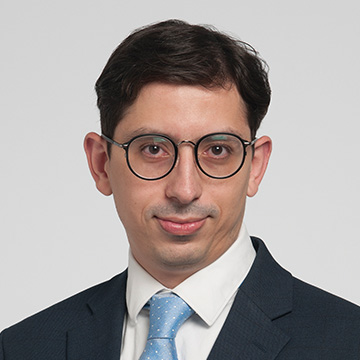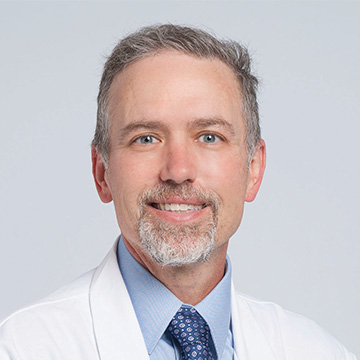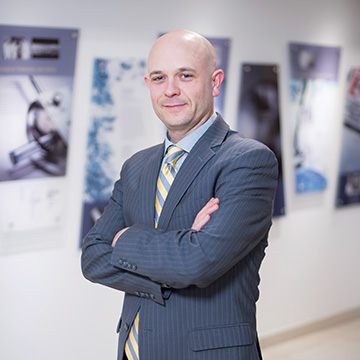Evolution of an Idea
Can artificial intelligence point the way to better spine care? Go behind the scenes on one team’s journey from innovation to invention.
FEATURE
By John Soeder
Dr. Thomas Mroz performs spine surgery. | Photo: Russell Lee
“Innovation is expensive, and philanthropy drives innovation. Philanthropy takes kernels of ideas that have promise and launches them into the stratosphere.”
— DR. MICHAEL STEINMETZ
Heterogeneity. Big word; potentially big problem. Particularly if we’re talking about spinal care. Let’s say you have lower back pain, one of the most common spinal conditions. Consult 10 different surgeons, and you might come away with nearly as many different recommendations for treating the issue. That’s heterogeneity: essentially, a hodgepodge of approaches. These variations exist for a multiplicity of reasons, including differences in the experience and training of the surgeons as well as a host of patient-specific factors. Led by Thomas Mroz, MD, and Ghaith Habboub, MD, a team of Cleveland Clinic innovators is developing a platform that harnesses the power of artificial intelligence (AI) to optimize spine care. This is their story.

Thomas Mroz, MD, is Chair of Cleveland Clinic’s Orthopaedic & Rheumatologic Institute.
Origins
Rewind to 2015. The roots of virtually any innovation, including this one, can be traced back to someone looking around and thinking: There must be a better way. That’s what happened seven years ago at Cleveland Clinic.
DR. MROZ: I saw the gaps in spine care. The heterogeneity across the country is well documented. Surgeries for one particular problem can be disparate, for a lot of reasons. If a patient has lumbar spinal stenosis, they should be getting one surgery. It should be consistent because we should be doing the absolute best thing for a patient, regardless of where they’re entering the healthcare system, anywhere in the nation.
At the same time, I also saw an opportunity to better utilize the advanced computing that we now have at our fingertips. We have capabilities that few people even dreamed about 50 years ago. There’s so much data about every patient in their electronic medical record.
My goal was to use advanced computing to analyze a comprehensive set of data points, in real time, to provide a more meaningful encapsulated vision of a patient and to help us make the best decision for improving the quality of care while driving down the cost.
DR. HABBOUB: I was still a resident when the project began. It grew out of a series of conversations. Dr. Mroz and I talked all the time about the future of spine care. Could we sum up all these patient characteristics in a way that would tell us a story about the patient and help us make a better decision about care? Dr. Mroz was senior staff. I was a trainee. But we shared a vision.
DR. STEINMETZ: I’ve been involved more or less from the beginning. My role has been to provide clinical perspective. I’m a sounding board for the pragmatic application. How do we do this?
MEESE: In the innovation field, we use the term “white space” to describe where opportunities exist to disrupt the market. At Cleveland Clinic Innovations, we work with inventors to develop their ideas and bring them to market in order to positively impact patients’ lives. To get things rolling, they’ll submit an invention disclosure form with us. The first time I reviewed the disclosure for the AI-guided spine care project, I was immediately excited about its disruptive potential.

Ghaith Habboub, MD, is a Cleveland Clinic neurosurgeon.
How to Build a Better Crystal Ball
If this were a case study about, say, a new heart valve, we could show you a blueprint or a photograph of a new heart valve. It’s a little trickier to paint a picture of the invention at the center of this story — somehow, a flowchart or line after line of computer code just wouldn’t do it justice. So, what is AI-guided spine care, anyway?
DR. MROZ: It’s a decision-making tool to help us predict which intervention is going to result in the best outcome for a patient. It can tell us your chances for meaningful improvement if you have surgery. If surgery isn’t the best option, it can send you down a different care pathway that will be more advantageous for you. It’s precision medicine.
DR. HABBOUB: The innovation is a modular algorithm. It’s complex enough to get the job done, but it’s also the simplest it can be to get the job done. That’s known as Occam’s razor.
DR. MROZ: For us, the biggest turning point was developing a quantifiable method to judge a patient’s outcome. We came up with something called “the utilization metric.” Essentially, it’s a mathematical formula that looks at everything that happens to a patient after surgery: How many office visits and phone calls? How many imaging studies? And so on. We look at all these factors to determine if an outcome was successful.
After the project was launched, it took the better part of two years just to navigate the necessary internal reviews and approvals. Then the team created a beta model. They named it HAL, after the supercomputer in 2001: A Space Odyssey. In addition to having a healthy sense of humor, Dr. Mroz and Dr. Habboub play off each other’s strengths.
DR. STEINMETZ: Everybody was talking about big data. But what does that really mean, and what do you do with it? Dr. Mroz had the foresight to say, “We can use this in a meaningful way.” That was a light-bulb moment. He had this big idea, and Dr. Habboub had the technical expertise to pursue it. He’s a savant, a self-taught expert who really understands artificial intelligence and machine learning.
MEESE: Early on, we had a meeting where Dr. Mroz and Dr. Habboub fully committed themselves to this process. It takes a lot of sweat equity, not to mention blood and tears. They give everything of themselves.

Michael Steinmetz, MD, is Chair of Cleveland Clinic’s Department of Neurosurgery and Director of the Center for Spine Health.
A Donor Saves the Day
To keep the project moving forward, philanthropic support was essential. A generous gift from the Connor Group Kids & Community Partners of Dayton, Ohio, provided critical funding for an external partner with healthcare data expertise.
DR. MROZ: Philanthropy was incredibly important. Without it, we couldn’t have pulled this off.
At the time, we didn’t have the data scientists or the data engineers in-house who could pull this off. So we contracted with an external company to engineer the data in such a way that it could be used.
In the 21st century, data is an invaluable natural resource. As a health system, Cleveland Clinic has a tremendous opportunity and obligation to use our data to do things like this.
DR. STEINMETZ: Philanthropy made this happen. It’s hard to get a federally funded grant to support an innovation like this because it’s not necessarily research. It’s really driving patient care. Innovation is expensive, and philanthropy drives innovation. Philanthropy takes kernels of ideas that have promise and launches them into the stratosphere.

Thad Meese, MBA, is Associate Director of Innovations Technology Development at Cleveland Clinic.
Test Drive
At the 2018 annual meeting of the Congress of Neurological Surgeons, the team presented a preview of their work in progress. Over the course of a decade, approximately half of the 3,300 patients who underwent lumbar laminectomy (surgery to remove bone from the lower spine) at Cleveland Clinic had a successful outcome, with “minimal clinically important differences” in key metric categories. When the team fed data from those patients into the AI system, it predicted that the success rate would have improved to at least 75% with AI guidance. A simulated cost analysis demonstrated cost savings of up to $25,000 per case.
DR. HABBOUB: To see that big jump in the success rate — that was very exciting for us.
DR. MROZ: It was a milestone. But there hasn’t been just one epiphany. We’ve hit so many little milestones along the way. We’ve probably had at least two meetings per week over the past few years. We have different milestones we need to make. With each milestone comes a quantum of progress.
DR. STEINMETZ: Through it all, I’ve been cautiously optimistic. There were times when I thought: Can we pull it off? But Dr. Mroz is very charismatic. Like, “We’re going to do this!” I believe in him, and I believe in Dr. Habboub’s expertise.
The Shape of Things to Come
The team continues to fine-tune the platform. If all goes well, it could be up and running next year.
DR. MROZ: What we’re doing now is trying to enhance the model with a different type of artificial intelligence called deep learning. It will likely involve image recognition and quantification of features in each target image. If we’re looking at an MRI, for example, we want to be able to automate the measurements of the spinal canal to see how tight it is, then use those numbers to enhance our decision-making capability. We’re creating one more layer of information for the model to run on, to see if we can improve the accuracy of our output.
The next step is to validate it, to make sure what the model is predicting is in fact occurring. From there, our hope is that the platform will be deployed within Cleveland Clinic by mid-2023. We’re maybe 12 to 18 months away from an opportunity to license this technology to a company that would help us bring it to market.
Beyond spine care, the technology could pave the way for similar AI tools to inform and improve care for hypertension and other chronic diseases.
DR. MROZ: This journey has created a pathway for other types of discovery. Hopefully, we’ve built a runway for future efforts when it comes to utilizing our data repositories.
MEESE: It’s all about a more personalized approach to medicine. When treatment decisions are based in part on data from a patient’s specific medical care over time, the opportunities for optimal outcomes of current clinical decision go up.
DR. STEINMETZ: For some, the idea of having a computer guide clinical care might be scary. How can a machine tell you what to do? The computer can’t see everything we see. It’s more than zeroes and ones. The person-to-person interaction will always matter. But we’re learning to live better and work better in harmony with these technologies.
DR. HABBOUB: You start with good intentions and a clear goal. Then you realize you have a lot of missing pieces that you need to put together to make everything work. As is the case with many innovations, the complexity of the problem has been eyeopening. But this project ultimately has been extremely rewarding.
DR. MROZ: There’s a need for this. We want to improve patient care, not only at Cleveland Clinic, but across the nation. We want healthcare to be different. We want it to be better.
